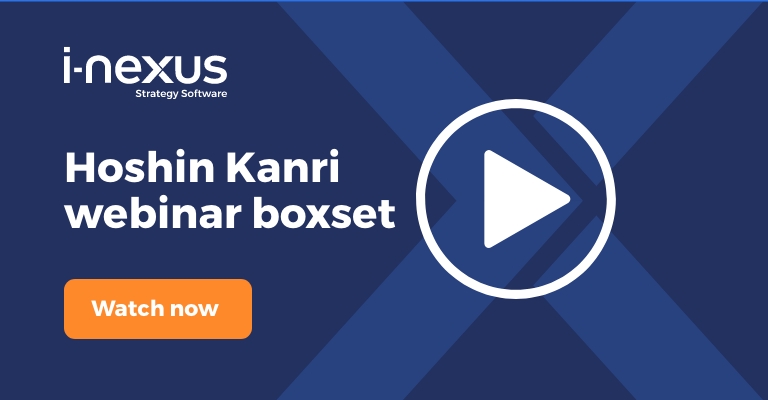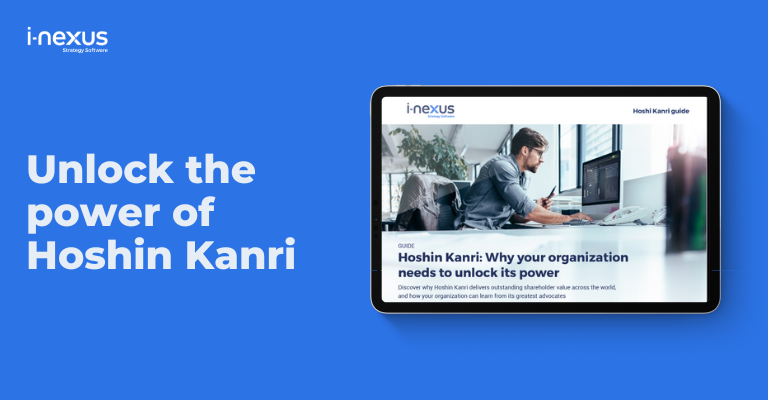With many tools available to your business for executing your strategy, the combination of PDCA, Lean and Agile within the Hoshin framework is a powerful arsenal.
Written by: Carolyn Gibson, Senior Strategy Advisor
This is the third in a series of articles around popular strategy deployment and execution methodologies, describing what they are and how they can be used individually or together to help achieve your organization’s goals.
If you missed them, the first two articles addressed Hoshin Kanri v 4DX v MBO and Hoshin Kanri x Balanced Scorecard, respectively.
This article looks at some of the methodologies specifically focused on execution - PDCA, Lean and Agile - and how these can all be used together in a single organization within the Hoshin Kanri framework.
Recapping Hoshin Kanri
Hoshin Kanri - also called Policy Deployment - is a full business system for deploying and executing an organization’s strategy (click here for a detailed description of its methodology and toolset).
An organization’s strategy may often be focused around optimizing an existing process or product to create even more value for the customer.
In Hoshin terms, there would be one or more Improvement Priorities to achieve this step-change in value.
For instance, if your annual goal is to increase sales by 10% via word of mouth referrals, then two Improvement Priorities might be:
- Increasing customer satisfaction in after-sales service, and
- Increasing post-sale visibility via social media marketing.
PDCA, Lean Management or Agile are three execution methodologies you can use to deliver these Improvement Priorities.
PDCA: Plan - Do - Check - Act
The most basic one is PDCA: The Plan-Do-Check-Act cycle, also called the Deming cycle after W. Edwards Deming who popularized it in the late 1950s, is a scientific method for Continuous Improvement.
Refreshingly, it simply does what it says on the tin.
It is sometimes also called PDSA, Plan-Do-Study-Act, to emphasize the need for a detailed review of the results.
In our scenario, PDCA would be used to plan a new training course for after-sales agents, test it on a first group, and then check or study the effect, acting early and often make improvements to the course over time.
PDCA may even determine that the training course is not effective and recommend a different plan of action.
Lean
Lean Management is a highly structured methodology that delivers customer value through removing waste and optimizing flow in an organization’s processes.
It has five key principles:
- Understanding what the customer values
- Determining how that value is created
- Ensuring smooth process flow
- Applying demand-driven pull, and
- Constantly aiming for perfection.
This meticulous approach is key to driving improvements over time and is at the heart of the world-famous Toyota Production System.
To address the after-sales service improvement priority, a Lean approach would be to:
- Understand what the customer values in the after-sales service
- Investigate how the value stream creates this value for the customer
- Remove what doesn’t create value, or inhibits flow, from the process
- Explore how the customer might be able to pull through what they need
- Then make improvements, testing and tweaking in order to perfect the after-sales process over time.
Agile
Agile originated as an approach to software development, starting with the publication of the Agile Manifesto in 2001.
Its principles of cross-functional collaboration, of self-organizing teams, of customer involvement, and of delivering iterative, incremental changes, have been promoted to ensure that project deliverables better reflect customer requirements and minimize major errors.
Again, in our example, one or more Agile teams might be mobilized to develop and test many different incremental changes to post-sale social media marketing, in order to find out what works best in raising the company’s profile in a way that generates more recommendations.
Hoshin Kanri - the framework to apply PDCA, Agile and Lean
As you can see, the three approaches can all be applied to delivering the Improvement Priorities.
PDCA is a more generic, flexible tool, whereas Lean and Agile are very structured in their approaches to generating value-based solutions.
However, not one of them explicitly builds in alignment to the overall strategy of the organization.
This is where the Hoshin Kanri business system can provide a useful framework:
- Hoshin Kanri provides organizational alignment around the vision
It requires laser-like focus on the few Improvement Priorities that are set out in the strategy.
This reduces both wasted effort (i.e. pet projects) and friction between departments.
Agile and Lean in particular can take on a life of their own within an organization; having a mechanism to ensure focus is vital to long-term success. - Hoshin Kanri creates a culture of accountability
Execution teams not only know what they must achieve but also have a higher level of commitment to the outcome, because of their early participation in strategic planning. - Hoshin Kanri reinforces cross-organizational cooperation
Agile, with its cross-functional teams, and Lean, with its value-stream focus, both thrive on the breaking of silo thinking.
Hoshin Kanri supports this from the top down through its catchball process. - Hoshin Kanri mandates a learning mindset
Gone are the days of creating strategy in a weekend retreat and reviewing it only the year after.
Hoshin Kanri’s regular cadence of reviews allows strategy to evolve with the insights gained from execution.
PDCA, Agile and Lean are all learning strategies that work well within Hoshin.
The final verdict
In summary, there are many ways to execute you organization’s strategy.
The strategic framework provided by Hoshin Kanri or a similar tool, must come first.
After that, it is not enough to buy in the tools for execution; you must learn how to use them within your strategic context.
Like this article, there is a lot of information online that can get you started, but that is just the first step.
Great Strategy Execution is a journey that takes time, patience and resources.
Plan, Do, Check, Act - and repeat!
Continue learning about Hoshin Kanri
Click here for further information on Hoshin Kanri, and continue your journey with these recommendations:
- 8 common challenges to adopting Hoshin Kanri: What are the typical hurdles to adopting Hoshin and how can you overcome them? Read our blog to learn the answers.
- Danaher, Ingersoll Rand and Xerox: Policy Deployment in practice: Learn why the experiences of these companies can teach us a lot about adopting Hoshin.
- Download our Key to Strategy Execution eBook: While Hoshin, PDCA, Agile and Lean can lead to the results your business needs, what will tie them all together for sustained success? Download our eBook to find out.
About the author
Carolyn Gibson is a senior strategy advisor and certified Hoshin Kanri facilitator working with Fortune 500 companies on building their Strategy Execution capabilities. Her career spans disciplines, industries and locations for over twenty years, with a golden thread running throughout of an obsessive focus on the mechanical detail of how organizations achieve their goals.




